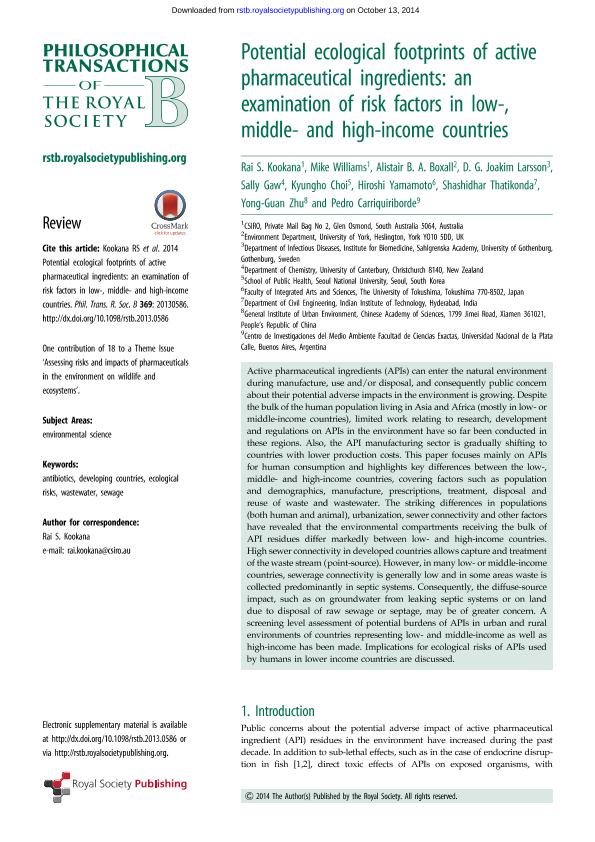Mostrar el registro sencillo del ítem
dc.contributor.author
Kookana, Rai S.
dc.contributor.author
Williams, Mike
dc.contributor.author
Boxall, Alistair B. A.
dc.contributor.author
Larsson, D. G. Joakim
dc.contributor.author
Gaw, Sally
dc.contributor.author
Choi, Kyungho
dc.contributor.author
Yamamoto, Hiroshi
dc.contributor.author
Thatikonda, Shashidhar
dc.contributor.author
Zhu, Yong Guan
dc.contributor.author
Carriquiriborde, Pedro

dc.date.available
2019-07-29T22:56:28Z
dc.date.issued
2014-11
dc.identifier.citation
Kookana, Rai S.; Williams, Mike; Boxall, Alistair B. A.; Larsson, D. G. Joakim; Gaw, Sally; et al.; Potential ecological footprints of active pharmaceutical ingredients: An examination of risk factors in low-, middle- and high-income countries; The Royal Society; Philosophical Transactions of the Royal Society B: Biological Sciences; 369; 1656; 11-2014; 1-16
dc.identifier.issn
0962-8436
dc.identifier.uri
http://hdl.handle.net/11336/80543
dc.description.abstract
Active pharmaceutical ingredients (APIs) can enter the natural environment during manufacture, use and/or disposal, and consequently public concern about their potential adverse impacts in the environment is growing. Despite the bulk of the human population living in Asia and Africa (mostly in low- or middle-income countries), limited work relating to research, development and regulations on APIs in the environment have so far been conducted in these regions. Also, the API manufacturing sector is gradually shifting to countries with lower production costs. This paper focuses mainly on APIs for human consumption and highlights key differences between the low-, middle- and high-income countries, covering factors such as population and demographics, manufacture, prescriptions, treatment, disposal and reuse of waste and wastewater. The striking differences in populations (both human and animal), urbanization, sewer connectivity and other factors have revealed that the environmental compartments receiving the bulk of API residues differ markedly between low- and high-income countries. High sewer connectivity in developed countries allows capture and treatment of the waste stream (point-source). However, in many low- or middle-income countries, sewerage connectivity is generally low and in some areas waste is collected predominantly in septic systems. Consequently, the diffuse-source impact, such as on groundwater from leaking septic systems or on land due to disposal of raw sewage or septage, may be of greater concern. A screening level assessment of potential burdens of APIs in urban and rural environments of countries representing low- and middle-income as well as high-income has been made. Implications for ecological risks of APIs used by humans in lower income countries are discussed.
dc.format
application/pdf
dc.language.iso
eng
dc.publisher
The Royal Society

dc.rights
info:eu-repo/semantics/openAccess
dc.rights.uri
https://creativecommons.org/licenses/by-nc-sa/2.5/ar/
dc.subject
Antibiotics
dc.subject
Developing Countries
dc.subject
Ecological Risks
dc.subject
Sewage
dc.subject
Wastewater
dc.subject.classification
Ciencias Medioambientales

dc.subject.classification
Ciencias de la Tierra y relacionadas con el Medio Ambiente

dc.subject.classification
CIENCIAS NATURALES Y EXACTAS

dc.title
Potential ecological footprints of active pharmaceutical ingredients: An examination of risk factors in low-, middle- and high-income countries
dc.type
info:eu-repo/semantics/article
dc.type
info:ar-repo/semantics/artículo
dc.type
info:eu-repo/semantics/publishedVersion
dc.date.updated
2019-06-14T18:38:59Z
dc.journal.volume
369
dc.journal.number
1656
dc.journal.pagination
1-16
dc.journal.pais
Reino Unido

dc.journal.ciudad
Londres
dc.description.fil
Fil: Kookana, Rai S.. CSIRO Exploration and Mining; Australia
dc.description.fil
Fil: Williams, Mike. CSIRO Exploration and Mining; Australia
dc.description.fil
Fil: Boxall, Alistair B. A.. University of York; Reino Unido
dc.description.fil
Fil: Larsson, D. G. Joakim. University Goteborg; Suecia
dc.description.fil
Fil: Gaw, Sally. University of Canterbury; Nueva Zelanda
dc.description.fil
Fil: Choi, Kyungho. Seoul National University; Corea del Sur
dc.description.fil
Fil: Yamamoto, Hiroshi. University of Tokushima; Japón
dc.description.fil
Fil: Thatikonda, Shashidhar. Indian Institute of Technology; India
dc.description.fil
Fil: Zhu, Yong Guan. Chinese Academy of Sciences; República de China
dc.description.fil
Fil: Carriquiriborde, Pedro. Consejo Nacional de Investigaciones Científicas y Técnicas. Centro Científico Tecnológico Conicet - La Plata; Argentina. Universidad Nacional de La Plata. Facultad de Ciencias Exactas. Departamento de Química. Centro de Investigaciones del Medio Ambiente; Argentina
dc.journal.title
Philosophical Transactions of the Royal Society B: Biological Sciences

dc.relation.alternativeid
info:eu-repo/semantics/altIdentifier/url/https://royalsocietypublishing.org/doi/full/10.1098/rstb.2013.0586
dc.relation.alternativeid
info:eu-repo/semantics/altIdentifier/doi/http://dx.doi.org/10.1098/rstb.2013.0586
dc.relation.alternativeid
info:eu-repo/semantics/altIdentifier/url/https://www.ncbi.nlm.nih.gov/pmc/articles/PMC4213596/
Archivos asociados
